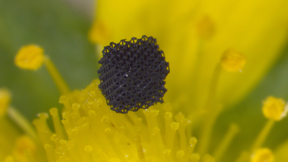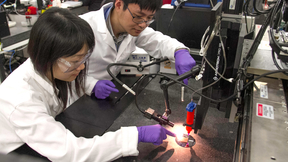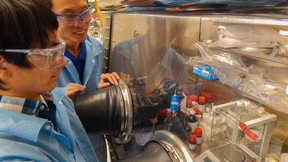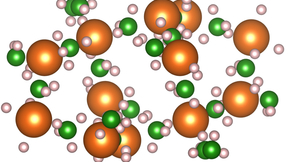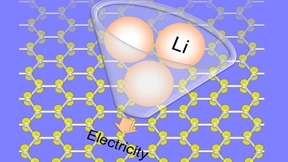Back
Laboratory for Energy Applications for the Future
LLNL and Virginia Tech researchers achieve more complex 3D-printed graphene aerogel
Graphene aerogel is lighter than air but as strong as steel, and it’s already proven useful in aerospace, energy storage and insulation. While there have been recent advances in 3D printing of the novel material, achieving complex structures has been elusive, hampering the unique material’s full potential. To date, 3D printing of graphene aerogel has been done using direct…
Using microbes to convert CO2 to natural gas
Lawrence Livermore National Laboratory (LLNL), in collaboration with Southern California Gas Co. and Stanford University, are using microbes to convert carbon dioxide directly to renewable natural gas. The U.S. Department of Energy recently awarded the power-to-gas project $800,000. SoCalGas will provide co-funding of $400,000 in addition to $125,000 of seed funding it…
A Solid Hydrogen-Storage Solution
At Lawrence Livermore, early-stage research to store hydrogen in solid materials, such as metal hydrides, could be a boon for advancing the hydrogen fuel economy. New results from these efforts, gleaned from this multidisciplinary approach, are reinvigorating scientists engaged in creating a technology infrastructure to produce, distribute, and store hydrogen for fuel cell…
Lab scientists to improve energy efficiency of copper catalysts that convert CO2 to methane
Lawrence Livermore National Laboratory (LLNL) researchers have received $1 million from the Department of Energy to improve the energy efficiency of copper-based catalysts to convert carbon dioxide into methane and other valuable hydrocarbon products. Led by LLNL’s Juergen Biener, the project will help meet the nation’s future energy needs by converting low-cost, abundant…
Scientists find 'frustration' in battery materials
Adding carbon atoms to a new type of solid lithium ion battery could make it charge faster and more safely. Solid-state lithium-ion batteries can provide dramatically improved safety, voltage and energy density compared with today’s batteries, which use liquid components. They could be used in electric vehicles, as well as in power electronics. However, they are still in…
Looking to the sun to create hydrogen fuel
When Lawrence Livermore scientist Tadashi Ogitsu leased a hydrogen fuel-cell car in 2017, he knew that his daily commute would change forever. There are no greenhouse gases that come out of the tailpipe, just a bit of water vapor. The market for hydrogen cars is growing. According to a recent report by the California Energy Commission and the California Air Resources Board…
A Reversible Reaction Captures Carbon
To combat climate change and other anthropogenic environmental impacts, researchers have identified and analyzed major sources of pollution.
LLNL researchers turn to bioengineered bacteria to increase U.S. supply of rare earth metals
To help increase the U.S. supply of rare earth metals, a Lawrence Livermore National Laboratory (LLNL) team has created a new way to recover rare earths using bioengineered bacteria. Rare earth elements (REEs) are essential for American competitiveness in the clean energy industry because they are used in many devices important to a high-tech economy and national security,…
It's something in the water: LLNL scientists extract hydrogen as potential fuel source
Lawrence Livermore National Laboratory (LLNL) scientists have developed a technique that helps extract hydrogen from water efficiently and cheaply. Hydrogen can be used as a clean fuel in fuel cells, which produce power, with water and heat as the only byproducts. As a zero-emission fuel, the hydrogen can be recombined with oxygen to produce electric power on demand, such…
From the Laboratory to the World
Yongqin Jiao is the principal investigator of MicroMiners, a project focused on rare-earth bioadsorption, or using genetically engineered bacteria to recover rare-earth elements from sources where levels are so low that recovery by ordinary means would be prohibitively expensive.
Scientists explore use of 3D printing to speed up target production for testing material strength
Advanced 3D printing promises to redefine manufacturing in critical industries such as aerospace, transportation and defense, and now, Lawrence Livermore National Laboratory is exploring the use of 3D printing to achieve unprecedented flexibility in producing "on-demand" targets for testing how materials behave under extreme conditions. Through an additive manufacturing…
Reducing Reliance on Critical Materials
High-technology products, from car motors to fluorescent lighting, often rely on small amounts of scarce raw materials that possess key properties, such as strength, thermal resistivity, and magnetism.
Researchers 3D print ultralight supercapacitors
For the first time ever, scientists at Lawrence Livermore National Laboratory and UC Santa Cruz have successfully 3D-printed supercapacitors using an ultra-lightweight graphene aerogel, opening the door to novel, unconstrained designs of highly efficient energy storage systems for smartphones, wearables, implantable devices, electric cars and wireless sensors.Using a 3D…
Using hydrogen to enhance lithium ion batteries
Lawrence Livermore National Laboratory scientists have found that lithium ion batteries operate longer and faster when their electrodes are treated with hydrogen.Lithium ion batteries (LIBs) are a class of rechargeable battery types in which lithium ions move from the negative electrode to the positive electrode during discharge and back when charging.The growing demand…
It's solid: storing hydrogen in a new form
As part of a tri-lab consortium, Lawrence Livermore National Laboratory researchers will develop tools and understanding necessary for designing new solid-state materials for storing hydrogen gas.Storage of hydrogen onboard vehicles is one of the critical enabling technologies for hydrogen-fueled transportation systems that can reduce oil dependency and mitigate the long…
Supercapacitors Yield Energetic Secrets
In the race for advanced energy storage systems, researchers are increasingly turning to the supercapacitor, a seemingly straightforward device made attractive by its many advantages over most batteries, including higher power density, faster charge–discharge cycling, enhanced safety, lower cost, and better endurance.
Diving into the Dynamics of Evolving Hydrogen
Livermore scientists are studying a process that uses sunlight as the driver for producing hydrogen fuel.
Microcapsules capture carbon safely
Using the same baking soda found in most grocery stores, Lawrence Livermore scientists, along with colleagues from Harvard University and the University of Illinois at Urbana-Champaign, have created a significant advance in carbon dioxide capture.The team developed a new type of carbon capture media composed of core-shell microcapsules, which consist of a highly permeable…
Livermore team awarded for hydrogen production research
Three Lawrence Livermore researchers have received the Department of Energy's 2014 Hydrogen Production R&D Award for developing a system that uses sunlight to split water molecules, producing hydrogen. Shared with collaborators from the National Renewable Energy Laboratory (NREL)and the University of Nevada, Las Vegas (UNLV), the award recognizes the team for its work…
Getting more life out of lithium-ion batteries
Your cell phone may stay charged longer due to advances in modeling lithium-ion battery storage capacity.New research indicates that lithium-ion batteries could benefit from a theoretical model created at Lawrence Livermore National Laboratory and Rice University that predicts how carbon components will perform as electrodes.The growing demand for energy storage emphasizes…

